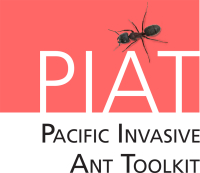Choosing a treatment option
We recommend an integrated pest management (IPM) approach to the control of ants, where possible. This is a combination of methods (pesticides, physical controls such as site hygiene) to minimise the use of pesticides and minimise the cost of control.
Depending on your situation, your treatment options include pesticide control, as well as non-toxic methods. At the very least a management plan should include movement controls, containment and effective waste management before embarking on pesticide treatment. A wide range of pesticides are available for treating ants. These include off-the-shelf products that are readily available in more developed states. These are appropriate for use around the home but won't be effective on a large scale. Some people make home-made pesticides, and there are some experimental treatments being researched.
Most of this section provides information on options for pesticide treatment in large scale settings (1 hectare or more).
Ant management can seem complex. A single treatment product might not be suitable for all ants in all situations. For example, little fire ants have been eradicated using granular baits in the Galapagos, which is a relatively dry environment with low vegetation. However, in areas that receive regular rainfall, granular baits break down too quickly. When ants such as little fire ants are nesting in trees, a granular bait is difficult to apply, so gel baits, which stick to vegetation and can be rehydrated by rain, are a better option.
Different pesticide regulatory requirements in different countries mean that some effective treatment options are not available everywhere.
Click on the shaded boxes in the matrix below (which is based on the case studies of best practice ant management) to identify potential solutions for your problem ant! Our spreadsheet of treatment products summarises most of the products available for controlling ants.
If your problem species is not one of the worst 5, there is little management information available, so as well as working through the flow chart, read about controlling other ants. For more information on the full range of pesticides available for the different ant species, please download this Excel workbook.
How treatment products are made
Poisons or toxicants are typically delivered together with in an attractant in a bait matrix. This matrix may be in the form of a solid, a powder, a paste or a liquid. The composition of this bait matrix is tailored to the food preferences of the target ant species (the attractant).
Ants may be broadly separated into meat/grease ants and sugar ants depending on whether they mostly forage for protein or carbohydrates.These preferences may differ depending on which point in their life cycle the ants are in, or what the prevailing weather conditions are. For example, when larvae are being fed there will be increased foraging for protein. Long periods of rain dilute available sugar resources, so there will be increased demand for carbohydrates. It is therefore essential to understand the target species' life cycle and biology when planning treatment. In the Pacific Islands, where temperatures rarely fall below 20°C, breeding can be assumed to occur year round.
A particular bait matrix or treatment product may be successful in managing a species in one environment but not another. When trying to manage an invasive ant species, it is important to gather as much information about baits that have been successful in environments comparable to your own before commencing any management activity.
Read the case studies of ant management actions in the Pacific region to find examples of treatment options in situations similar to yours.
